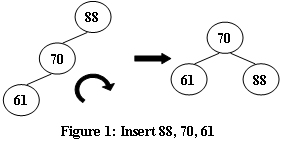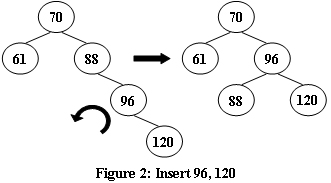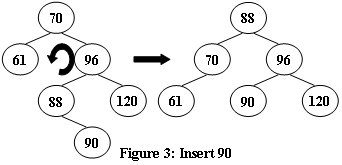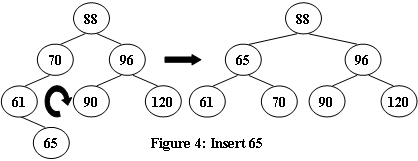PAT (Advanced Level) Practice
1066 Root of AVL Tree (25分)
An AVL tree is a self-balancing binary search tree. In an AVL tree, the heights of the two child subtrees of any node differ by at most one; if at any time they differ by more than one, rebalancing is done to restore this property. Figures 1-4 illustrate the rotation rules.




Now given a sequence of insertions, you are supposed to tell the root of the resulting AVL tree.
Input Specification:
Each input file contains one test case. For each case, the first line contains a positive integer N (≤20) which is the total number of keys to be inserted. Then N distinct integer keys are given in the next line. All the numbers in a line are separated by a space.
Output Specification:
For each test case, print the root of the resulting AVL tree in one line.
Sample Input 1:
5
88 70 61 96 120
Sample Output 1:
70
Sample Input 2:
7
88 70 61 96 120 90 65
Sample Output 2:
88
个人代码:
#include <stdio.h>
#include <algorithm>
// #define LOCAL
using namespace std;
typedef struct AVLNode { //AVL树结点
int height, val;
struct AVLNode *lchild, *rchild, *parent;
} AVLNode, *AVLTree;
// void InitAVLTree (AVLTree &T) { //初始化
// T -> lheight = 0;
// T -> rheight = 0;
// T -> lchild = NULL;
// T -> rchlid = NULL;
// T -> parent = NULL;
// }
AVLNode *AVLTreeInsert (AVLTree &T, int val) { //插入新的结点
if (T == NULL) {
T = (AVLTree)malloc(sizeof(AVLNode));
T->val = val;
T->lchild = NULL;
T->rchild = NULL;
T->parent = NULL;
return T;
} else if (val < T->val) {
return AVLTreeInsert(T->lchild, val);
} else {
return AVLTreeInsert(T->rchild, val);
}
}
int AVLTreeHeight (AVLTree &T) { //求高度
if (T == NULL) {
return 0;
} else {
int lheight, rheight;
lheight = AVLTreeHeight(T->lchild);
rheight = AVLTreeHeight(T->rchild);
T->height = max(lheight + 1, rheight + 1);
// printf("%d*\n", T -> height);
return T->height;
}
}
void SetParent (AVLTree &T) { //设置双亲结点
if (T == NULL) {
return;
}
if (T->lchild != NULL) {
T->lchild->parent = T;
SetParent(T->lchild);
}
if (T->rchild != NULL) {
T->rchild->parent = T;
SetParent(T->rchild);
}
}
void AVLTreeLrevov (AVLTree &p, AVLTree &T) { //左旋操作
if (p->parent->parent != NULL) {
if (p->parent->val < p->parent->parent->val) {
p->parent->parent->lchild = p;
} else {
p->parent->parent->rchild = p;
}
}
p->parent->rchild = p->lchild;
p->lchild = p->parent;
if (p->lchild->val == T->val) {
T = p;
T->parent = NULL;
}
}
void AVLTreeRrevov (AVLTree &p, AVLTree &T) { //右旋操作
if (p->parent->parent != NULL) { //首先判断该结点
if (p->parent->val < p->parent->parent->val) {
p->parent->parent->lchild = p;
} else {
p->parent->parent->rchild = p;
}
}
p->parent->lchild = p->rchild;
p->rchild = p->parent;
if (p->rchild->val == T->val) {
T = p;
T->parent = NULL;
}
}
// void visit (AVLTree T) { //前序遍历
// if (T != NULL) {
// printf("T->val=%d,T->height=%d--\n",T->val, T->height);
// visit (T->lchild);
// visit (T->rchild);
// }
// }
int main () {
#ifdef LOCAL
freopen("./in.txt", "r", stdin);
// freopen("./out.txt", "w", stdout);
#endif
int n;
scanf("%d", &n);
AVLTree T = NULL;
AVLNode *p = NULL;
// InitAVLTree (T);
for (int i = 0; i < n; i++) {
int lheight = 0, rheight = 0, value = 0; //左子树高度、右子树高度、值
int revov = 0; //标志需要进行的旋转操作,0-4代表结点类型,不操作,LL,LR,RL,RR
scanf("%d", &value);
p = AVLTreeInsert(T, value);
AVLTreeHeight(T);
SetParent(T);
while (p != NULL) { //找到第一个不平衡结点
if (p->lchild != NULL) { //左子树高度
lheight = p->lchild->height;
} else {
lheight = 0;
}
if (p->rchild != NULL) { //右子树高度
rheight = p->rchild->height;
} else {
rheight = 0;
}
if (abs(lheight - rheight) < 2) { //从插入点往上寻找双亲结点,使p为第一个不平衡结点
p = p->parent;
} else break;
}
if (abs(lheight - rheight) >= 2) { //p可能为NULL,可能为第一个不平衡结点
if (value < p->val) {
p = p->lchild; //需要进行LL/LR旋转操作
if (value < p->val) {
revov = 1; //LL旋转操作
} else {
revov = 2; //LR旋转操作
}
} else {
p = p->rchild; //需要进行RL/RR旋转操作
if (value < p->val) {
revov = 3; //RL旋转操作
} else {
revov = 4; //RR旋转操作
}
}
}
switch (revov) { //根据不平衡点类型选择旋转操作,旋转后注意重新设置双亲结点
case 0: //不是不平衡点,不进行操作
break;
case 1: //LL类型进行右旋操作
AVLTreeRrevov(p, T);
SetParent(T);
break;
case 2: //LR类型先进行左旋操作再进行右旋操作
p = p->rchild;
AVLTreeLrevov(p, T);
SetParent(T);
AVLTreeRrevov(p, T);
SetParent(T);
break;
case 3: //RL类型先进行右旋操作再进行左旋操作
p = p->lchild; //旋转的对象是
AVLTreeRrevov(p, T);
SetParent(T);
AVLTreeLrevov(p, T);
SetParent(T);
break;
case 4: //RR类型进行左旋操作
AVLTreeLrevov(p, T);
SetParent(T);
break;
}
// visit(T); //遍历一遍AVL树,检查是否正确
}
printf("%d", T->val); //已经成功构建AVL树,选择自己的操作
return 0;
}
思路提示:
建立AVL树的步骤如下:
- 首先定义AVL树的结点,包含高度、值、指向孩子结点和双亲结点的指针等信息
- 每读入一个结点,就要将他按照BST的排序规则插入AVL树中
- 每个结点插入后,检查AVL树中每个结点是否满足左右子树高度相差的绝对值不超过1,方法是从刚插入的结点往上找他的双亲结点(设置双亲结点的好处)
- 找到最近的一个不满足平衡条件的结点,根据LL、LR、RL、RR四种类型确定需要进行旋转的操作和对象
- 注意,当树的高度和双亲节点变化后,需要及时的通过函数更新






















 918
918











 被折叠的 条评论
为什么被折叠?
被折叠的 条评论
为什么被折叠?








